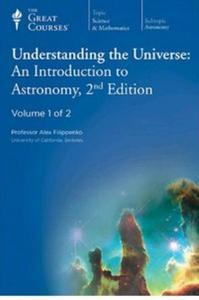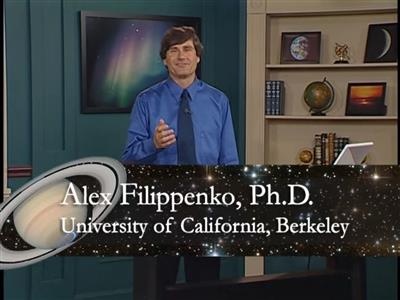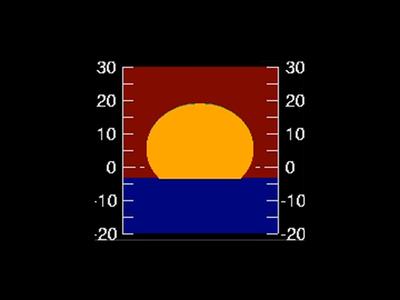This visually rich course is designed to provide a nontechnical description of modern astronomy, including the structure and evolution of planets, stars, galaxies, and the Universe as a whole. It includes almost all of the material in my first two astronomy courses for The Teaching Company, produced in 1998 and 2003, but with a large number of new images, diagrams, and animations. The discoveries reported in the 2003 course are integrated throughout these new lectures, and more recent findings (through mid-2006) are included, as well. Much has happened in astronomy during the past few years; we will discuss the most exciting and important advances.
Understanding the Universe: An Introduction to Astronomy, 2nd Edition
96xHDRip | MKV/AVC, ~545 kb/s | 960x720 | Duration: 49:53:48 | English: AAC, 48 KHz (2 ch) | + PDF Guides
Size: 11.3 Gb | Genre: Physics, Astronomy and Cosmology
Astronomical objects have been explored with breathtaking data obtained by the Hubble Space Telescope, the Chandra X-Ray Observatory, the Keck 10-meter telescopes, planetary probes, and other modern instruments. We will explore amazing phenomena, such as quasars, exploding stars, neutron stars, and black holes, and we will see how they increase our understanding of the physical principles of nature. We will also investigate recent newsworthy topics, such as the Cassini mission to Saturn, evidence for liquid water on ancient Mars, the discovery of many small bodies beyond Neptune in our Solar System, the detection of numerous planets around other stars, the nonzero mass of ghostly neutrinos, enormously powerful gamma-ray bursts, the conclusive evidence for a supermassive black hole in the center of our Milky Way Galaxy, the determination of the age of the Universe, the discovery of a long-range repulsive effect accelerating the expansion of the Universe, and progress in the unification of nature's fundamental forces. Scientifically reasonable speculations regarding the birth of the Universe, the possibility of multiple universes, and the probability of extraterrestrial life are also included.
This course concentrates on the most exciting aspects of our fantastic Universe and on the methods astronomers have used to develop an understanding of it. The lectures present, in clear and simple terms, explanations of how the Universe "works," as well as the interrelationships among its components. Reliance on basic mathematics and physics is minimal but appropriate in some sections to deepen the interested viewer's quantitative understanding of the material.
The course is divided into three major sections, each of which consists of several units. (These major sections are called "parts" during the lectures, but they are not to be confused with the eight 12-lecture "parts" used in packaging the lectures.)
There are 24 lectures in Section 1, entitled "Observing the Heavens." The first unit, "Celestial Sights for Everyone," describes simple daytime and nighttime observations that you can make to better appreciate the sky and what it contains. Various commonly observed phenomena, such as seasons, lunar phases, and eclipses, are also discussed. The second unit, "The Early History of Astronomy," covers the study of astronomy from the ancient Greeks through Newton, including the transition from geocentric (Earth-centered) to heliocentric (Sun-centered) models of the Universe. In the third unit, "Basic Concepts and Tools," we provide an overview of distance and time scales in the Universe to put our discussions in perspective. Because the study of light is of central importance to astronomy, we spend several lectures explaining its physical nature and utility. Modern telescopes, the main instruments used by astronomers, are also described.
Section 2, "The Contents of the Universe," consists of 46 lectures in 5 units. In the first unit, "Our Solar System," we discuss the major constituents of our own planetary system, including the Sun, planets and their moons, comets, asteroids, and Kuiper-belt objects. The discovery of a distant body larger than Pluto and the subsequent, highly controversial demotion of Pluto from planetary status made headlines worldwide. The formation of other stars and planetary systems, as well as the discovery of such extrasolar planets, is the subject of the second unit, "Other Planetary Systems." During the past decade, about 200 planets have been found orbiting other stars, making this one of the most exciting areas of modern astronomy. The search for extraterrestrial life is also described.
In the third unit of Section 2, "Stars and Their Lives," we learn about the properties of other stars and the various observations needed to deduce them. Nuclear reactions, the source of energy from the stars, are described, as well. We examine how stars eventually become red giants, subsequently shedding their outer layers to end up as dense white dwarfs, retired stars. The explosive fates of some rare types of stars are the subject of the fourth unit, "Stellar Explosions and Black Holes," and we explain how the heavy elements necessary for life are created. Bizarre stellar remnants include neutron stars and black holes, the realm of Einstein's general theory of relativity. We continue our exploration of black holes with such phenomena as black-hole evaporation and powerful gamma-ray bursts, as well as speculations that black holes are gateways to other universes. In the fifth unit, "The Milky Way and Other Galaxies," we extend our explorations to the giant collections of stars called galaxies, along the way examining evidence for mysterious dark matter.
Section 3, "Cosmology: The Universe as a Whole," comprises the final 26 lectures of the course in 3 units. The first unit, "Cosmic Expansion and Distant Galaxies," introduces the expansion of the Universe and shows how it is used to study the evolution of galaxies. We discuss active galaxies and quasars, in which matter is inferred to be falling into a central, supermassive black hole. In the second unit, "The Structure and Evolution of the Universe," aspects of the Universe, such as its age, geometry, and possible fate, are considered. We examine evidence for the stunning conclusion that the expansion of the Universe is currently accelerating. We also describe the cosmic microwave background radiation-the generally uniform afterglow of the Big Bang-as well as the tiny irregularities that reveal the presence of early density variations from which all of the large-scale structure of the Universe subsequently formed. The nature of dark energy accelerating the Universe is explored in terms of modern attempts to unify forces, such as string theory.
In the third and final unit, "The Birth of the Cosmos, and Other Frontiers," we examine the very early history of the Universe, showing how the lightest elements formed during a phase of primordial nucleosynthesis. The recognition of several troubling problems with the standard Big Bang theory led to a magnificent refinement-an inflationary epoch of expansion that lasted only a tiny fraction of a second. The possible connection between inflation and the currently accelerating expansion of space is also discussed. We then consider very speculative ideas regarding the birth of the Universe and the hypothesis of multiple universes. We end, in the last lecture, on a philosophical note, with some reflections on intelligent life in the cosmos and of our place in the grand scheme of things.
Lectures:
1. A Grand Tour of the Cosmos
2. The Rainbow Connection
3. Sunrise, Sunset
4. Bright Objects in the Night Sky
5. Fainter Phenomena in the Night Sky
6. Our Sky through Binoculars and Telescopes
7. The Celestial Sphere
8. The Reason for the Seasons
9. Lunar Phases and Eerie Lunar Eclipses
10. Glorious Total Solar Eclipses
11. More Eclipse Tales
12. Early Studies of the Solar System
13. The Geocentric Universe
14. Galileo and the Copernican Revolution
15. Refinements to the Heliocentric Model
16. On the Shoulders of Giants
17. Surveying Space and Time
18. Scale Models of the Universe
19. Light-The Supreme Informant
20. The Wave-Particle Duality of Light
21. The Colors of Stars
22. The Fingerprints of Atoms
23. Modern Telescopes
24. A Better Set of Eyes
25. Our Sun, the Nearest Star
26. The Earth, Third Rock from the Sun
27. Our Moon, Earth's Nearest Neighbor
28. Mercury and Venus
29. Of Mars and Martians
30. Jupiter and Its Amazing Moons
31. Magnificent Saturn
32. Uranus and Neptune, the Small Giants
33. Pluto and Its Cousins
34. Asteroids and Dwarf Planets
35. Comets-Gorgeous Primordial Snowballs
36. Catastrophic Collisions
37. The Formation of Planetary Systems
38. The Quest for Other Planetary Systems
39. Extra-Solar Planets Galore!
40. Life Beyond the Earth
41. The Search for Extraterrestrials
42. Special Relativity and Interstellar Travel
43. Stars-Distant Suns
44. The Intrinsic Brightnesses of Stars
45. The Diverse Sizes of Stars
46. Binary Stars and Stellar Masses
47. Star Clusters, Ages, and Remote Distances
48. How Stars Shine-Nature's Nuclear Reactors
49. Solar Neutrinos-Probes of the Sun's Core
50. Brown Dwarfs and Free-Floating Planets
51. Our Sun's Brilliant Future
52. White Dwarfs and Nova Eruptions
53. Exploding Stars-Celestial Fireworks!
54. White Dwarf Supernovae-Stealing to Explode
55. Core-Collapse Supernovae-Gravity Wins
56. The Brightest Supernova in Nearly 400 Years
57. The Corpses of Massive Stars
58. Einstein's General Theory of Relativity
59. Warping of Space and Time
60. Black Holes-Abandon Hope, Ye Who Enter
61. The Quest for Black Holes
62. Imagining the Journey to a Black Hole
63. Wormholes-Gateways to Other Universes?
64. Quantum Physics and Black-Hole Evaporation
65. Enigmatic Gamma-Ray Bursts
66. Birth Cries of Black Holes
67. Our Home-The Milky Way Galaxy
68. Structure of the Milky Way Galaxy
69. Other Galaxies-"Island Universes"
70. The Dark Side of Matter
71. Cosmology-The Really Big Picture
72. Expansion of the Universe and the Big Bang
73. Searching for Distant Galaxies
74. The Evolution of Galaxies
75. Active Galaxies and Quasars
76. Cosmic Powerhouses of the Distant Past
77. Supermassive Black Holes
78. Feeding the Monster
79. The Paradox of the Dark Night Sky
80. The Age of the Universe
81. When Geometry Is Destiny
82. The Mass Density of the Universe
83. Einstein's Biggest Blunder?
84. The Afterglow of the Big Bang
85. Ripples in the Cosmic Background Radiation
86. The Stuff of the Cosmos
87. Dark Energy-Quantum Fluctuations?
88. Dark Energy-Quintessence?
89. Grand Unification & Theories of Everything
90. Searching for Hidden Dimensions
91. The Shape, Size, and Fate of the Universe
92. In the Beginning
93. The Inflationary Universe
94. The Ultimate Free Lunch?
95. A Universe of Universes
96. Reflections on Life and the Cosmos
screenshot
Download link:
uploaded_net:
[Misafirler Kayıt Olmadan Link Göremezler Lütfen Kayıt İçin Tıklayın ! ]
[Misafirler Kayıt Olmadan Link Göremezler Lütfen Kayıt İçin Tıklayın ! ]
[Misafirler Kayıt Olmadan Link Göremezler Lütfen Kayıt İçin Tıklayın ! ]
[Misafirler Kayıt Olmadan Link Göremezler Lütfen Kayıt İçin Tıklayın ! ]
[Misafirler Kayıt Olmadan Link Göremezler Lütfen Kayıt İçin Tıklayın ! ]
[Misafirler Kayıt Olmadan Link Göremezler Lütfen Kayıt İçin Tıklayın ! ]
[Misafirler Kayıt Olmadan Link Göremezler Lütfen Kayıt İçin Tıklayın ! ]
[Misafirler Kayıt Olmadan Link Göremezler Lütfen Kayıt İçin Tıklayın ! ]
[Misafirler Kayıt Olmadan Link Göremezler Lütfen Kayıt İçin Tıklayın ! ]
[Misafirler Kayıt Olmadan Link Göremezler Lütfen Kayıt İçin Tıklayın ! ]
[Misafirler Kayıt Olmadan Link Göremezler Lütfen Kayıt İçin Tıklayın ! ]
[Misafirler Kayıt Olmadan Link Göremezler Lütfen Kayıt İçin Tıklayın ! ]
[Misafirler Kayıt Olmadan Link Göremezler Lütfen Kayıt İçin Tıklayın ! ]
[Misafirler Kayıt Olmadan Link Göremezler Lütfen Kayıt İçin Tıklayın ! ]
[Misafirler Kayıt Olmadan Link Göremezler Lütfen Kayıt İçin Tıklayın ! ]
[Misafirler Kayıt Olmadan Link Göremezler Lütfen Kayıt İçin Tıklayın ! ]
[Misafirler Kayıt Olmadan Link Göremezler Lütfen Kayıt İçin Tıklayın ! ]
bigfile_to:
[Misafirler Kayıt Olmadan Link Göremezler Lütfen Kayıt İçin Tıklayın ! ]
[Misafirler Kayıt Olmadan Link Göremezler Lütfen Kayıt İçin Tıklayın ! ]
[Misafirler Kayıt Olmadan Link Göremezler Lütfen Kayıt İçin Tıklayın ! ]
[Misafirler Kayıt Olmadan Link Göremezler Lütfen Kayıt İçin Tıklayın ! ]
[Misafirler Kayıt Olmadan Link Göremezler Lütfen Kayıt İçin Tıklayın ! ]
[Misafirler Kayıt Olmadan Link Göremezler Lütfen Kayıt İçin Tıklayın ! ]
[Misafirler Kayıt Olmadan Link Göremezler Lütfen Kayıt İçin Tıklayın ! ]
[Misafirler Kayıt Olmadan Link Göremezler Lütfen Kayıt İçin Tıklayın ! ]
[Misafirler Kayıt Olmadan Link Göremezler Lütfen Kayıt İçin Tıklayın ! ]
[Misafirler Kayıt Olmadan Link Göremezler Lütfen Kayıt İçin Tıklayın ! ]
[Misafirler Kayıt Olmadan Link Göremezler Lütfen Kayıt İçin Tıklayın ! ]
[Misafirler Kayıt Olmadan Link Göremezler Lütfen Kayıt İçin Tıklayın ! ]
[Misafirler Kayıt Olmadan Link Göremezler Lütfen Kayıt İçin Tıklayın ! ]
[Misafirler Kayıt Olmadan Link Göremezler Lütfen Kayıt İçin Tıklayın ! ]
[Misafirler Kayıt Olmadan Link Göremezler Lütfen Kayıt İçin Tıklayın ! ]
[Misafirler Kayıt Olmadan Link Göremezler Lütfen Kayıt İçin Tıklayın ! ]
[Misafirler Kayıt Olmadan Link Göremezler Lütfen Kayıt İçin Tıklayın ! ]Links are Interchangeable - No Password - Single Extraction
1 sonuçtan 1 ile 1 arası
-
25.08.2016 #1Banned



- Üyelik tarihi
- 05.06.2016
- Mesajlar
- 8.937
- Konular
- 0
- Bölümü
- Elektrik
- Cinsiyet
- Kadın
- Tecrübe Puanı
- 0
Understanding the Universe An Introduction to Astronomy,2nd Edition [reduced]
Konu Bilgileri
Users Browsing this Thread
Şu an 1 kullanıcı var. (0 üye ve 1 konuk)



 LinkBack URL
LinkBack URL About LinkBacks
About LinkBacks








 Alıntı
Alıntı
Konuyu Favori Sayfanıza Ekleyin